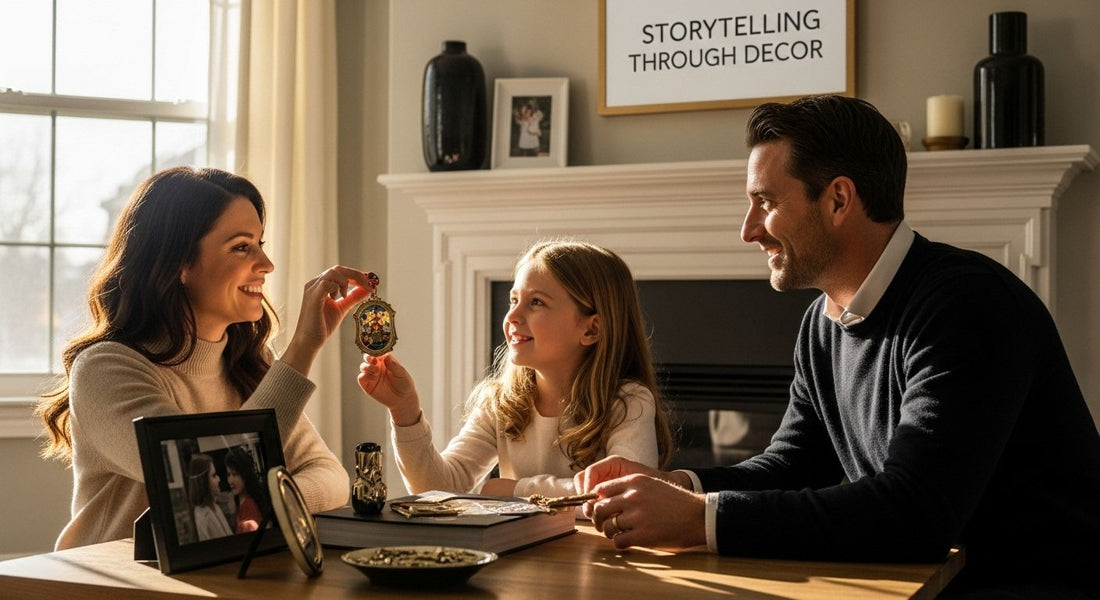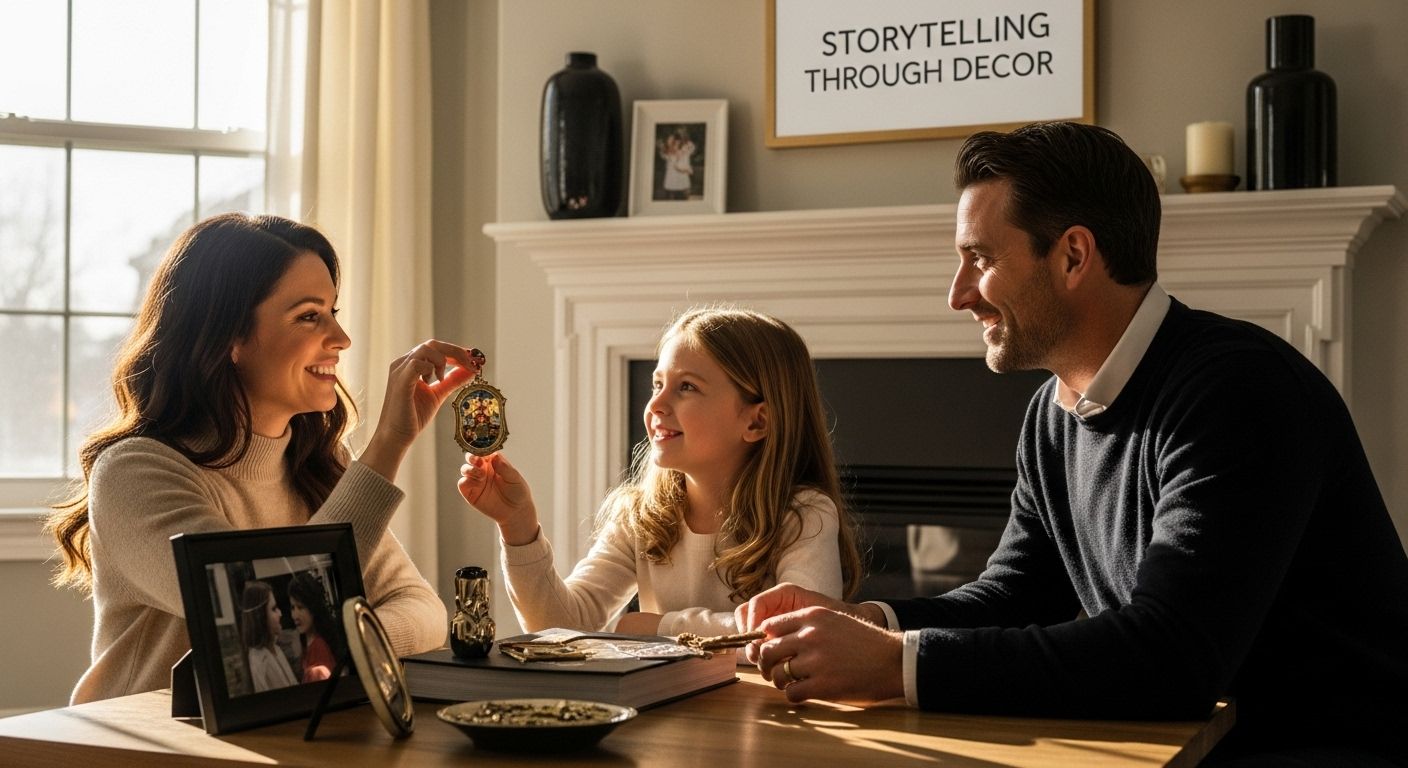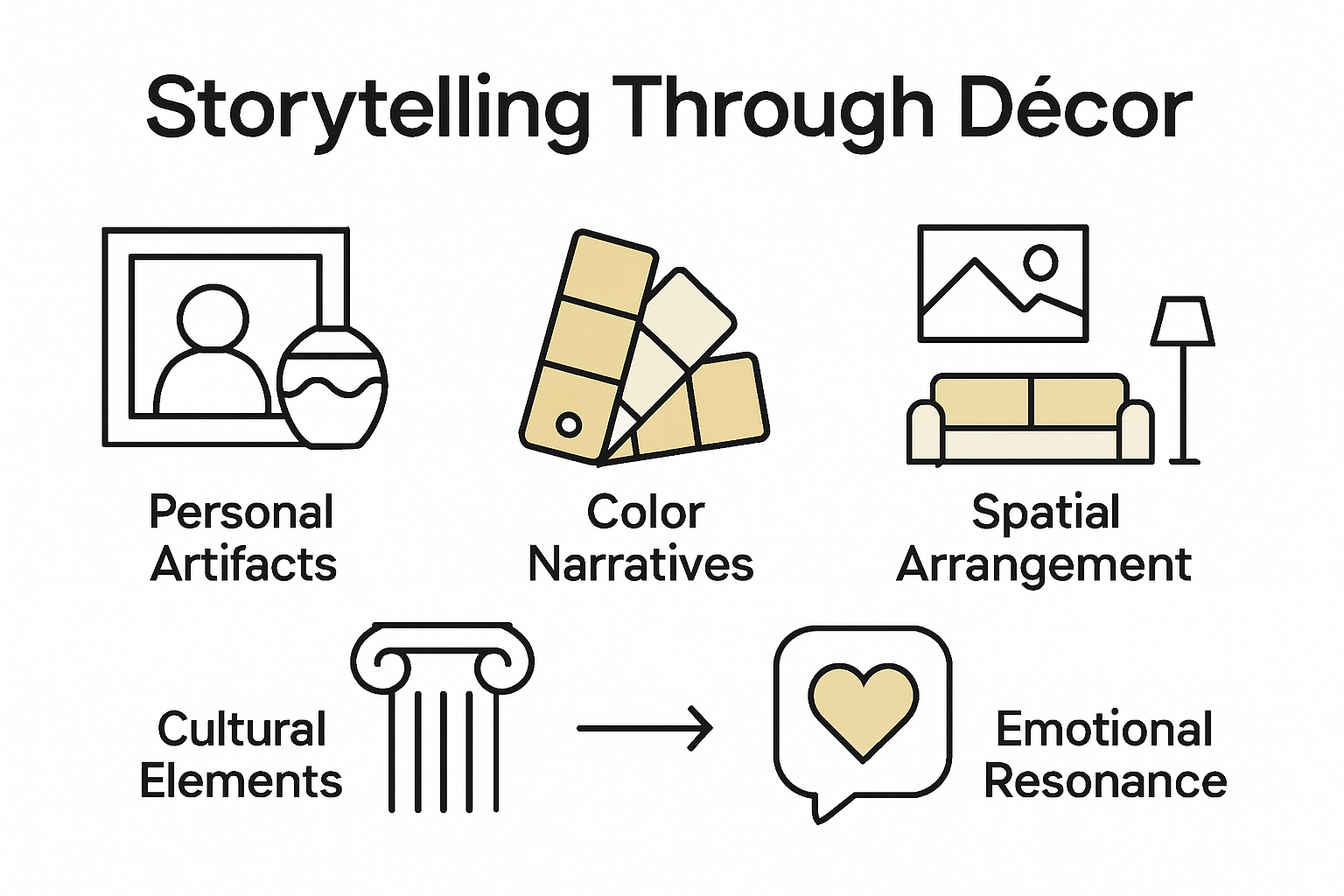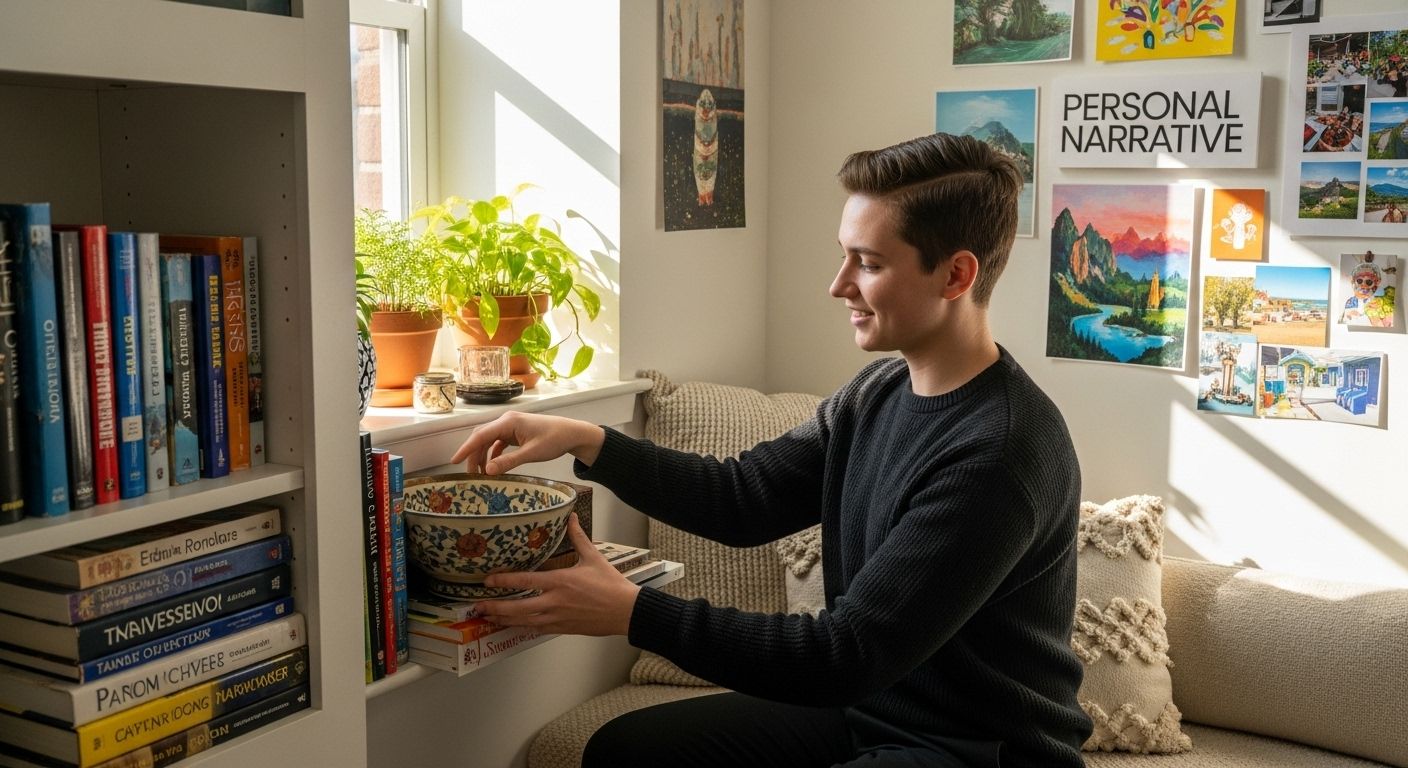
Understanding Storytelling Through Decor for Your Space
Storytelling through decor is changing the way people think about their homes. Forget just matching colors and following trends. Here is a surprising fact to consider: research shows that interior design elements can significantly impact your emotions and even influence your mental well-being. Instead of just picking what looks nice, imagine turning every object and color into a piece of your personal story.

Table of Contents
- What Is Storytelling Through Decor And Its Meaning?
- The Importance Of Decor In Crafting Personal Narratives
- Key Elements And Strategies For Effective Storytelling In Decor
- How Cultural And Personal Backgrounds Influence Decor Choices
- Real-World Examples: Successfully Telling Stories Through Decor
Quick Summary
| Takeaway | Explanation |
|---|---|
| Storytelling decor reflects personal narratives. | Decor can express individual experiences and emotions, creating a unique personal narrative in living spaces. |
| Curate personal artifacts for significance. | Select meaningful objects that resonate with your identity or life experiences to deepen the storytelling aspect of your decor. |
| Utilize color and placement strategically. | Thoughtful color palettes and spatial arrangements enhance emotional responses, shaping the overall narrative conveyed by the decor. |
| Incorporate cultural elements in design. | Use decorative pieces that represent your heritage, enriching your decor with deeper cultural significance and personal history. |
| Transform spaces into emotional landscapes. | Create environments that evoke memories and aspirations, allowing decor to communicate complex personal stories without words. |
What is Storytelling Through Decor and Its Meaning?
Storytelling through decor transforms living spaces from mere functional areas into personal narratives that reflect individual experiences, emotions, and journeys. This approach goes beyond traditional interior design by creating meaningful connections between physical environments and personal histories.
The Essence of Narrative Spaces
Storytelling through decor is an intentional design strategy where every item in a space communicates a specific aspect of personal identity. Objects are not randomly selected but carefully curated to represent significant moments, cultural backgrounds, personal achievements, or emotional connections. A family photograph, an inherited art piece, or a souvenir from travels can become powerful storytelling elements that reveal complex personal narratives.
According to User Experience Design experts, storytelling plays a crucial role in creating meaningful connections between people and their environments. This principle extends directly to interior design, where spaces become living canvases of personal expression.
Components of Storytelling Decor
The core components of storytelling through decor include:
- Personal Artifacts: Objects with deep personal significance
- Color Narratives: Color palettes that reflect emotional journeys
- Spatial Arrangements: Strategic placement that creates visual storytelling
- Cultural Elements: Decorative pieces representing heritage and identity
By thoughtfully integrating these elements, individuals transform their living spaces into dynamic, personal statements that communicate identity, values, and life experiences without uttering a single word. Each room becomes a chapter, each object a sentence in the ongoing narrative of personal life.
To clarify the components that make up storytelling decor, here is a table summarizing each key element and what it represents:
| Component | Description |
|---|---|
| Personal Artifacts | Objects with deep personal significance, like heirlooms or souvenirs |
| Color Narratives | Color palettes chosen to reflect emotional journeys and moods |
| Spatial Arrangements | Strategic placement of decor to visually communicate aspects of the story |
| Cultural Elements | Decorative pieces that represent heritage and cultural identity |
This table makes it easier to understand how different components work together to create a narrative within living spaces.
The Importance of Decor in Crafting Personal Narratives
Decor transcends aesthetic appeal, emerging as a profound medium for personal storytelling and emotional expression. It serves as a silent communicator of individual experiences, memories, and inner landscapes that words often struggle to articulate.
Psychological Dimensions of Personal Space
Personal spaces are more than physical environments they are psychological extensions of self. Each carefully selected decorative element represents a fragment of personal identity, functioning as a visual autobiography. A vintage family heirloom, a collection of travel mementos, or artwork acquired during significant life transitions become tangible representations of individual journeys and emotional landscapes.
Research from the National Library of Medicine reveals that interior design elements like color, lighting, and decoration significantly influence emotional perceptions and mental responses. These design choices are not merely decorative but integral to psychological well-being and personal narrative construction.
Narrative Elements in Personal Decor
The narrative potential of decor manifests through several key dimensions:
- Emotional Resonance: Objects that trigger meaningful memories
- Cultural Representation: Decorative pieces reflecting heritage and identity
- Personal Evolution: Items symbolizing different life stages and transformations
- Aspirational Storytelling: Decor that represents future goals and dreams
By intentionally curating living spaces, individuals create immersive environments that communicate complex personal stories. These spaces become living archives of personal experiences, allowing inhabitants and visitors to glimpse the rich, nuanced narratives embedded within seemingly ordinary objects.
The following table outlines the major narrative elements used in personal decor and their specific roles in expressing personal stories:
| Narrative Element | Role in Personal Decor |
|---|---|
| Emotional Resonance | Objects that trigger meaningful memories |
| Cultural Representation | Items reflecting heritage and cultural background |
| Personal Evolution | Symbols of different life stages and personal transformations |
| Aspirational Storytelling | Decor that represents dreams and future goals |
Referencing this table helps highlight the variety of ways decor can serve as a storytelling tool in your living space.
Key Elements and Strategies for Effective Storytelling in Decor
Effective storytelling through decor requires a strategic approach that transforms living spaces into deeply personal and emotionally resonant environments. By understanding and implementing specific design principles, individuals can craft narratives that speak volumes about their experiences, values, and inner worlds.
Design Principles of Narrative Decor
The foundation of storytelling through decor lies in intentional selection and arrangement of elements. Every object becomes a narrative device, carefully chosen to represent specific aspects of personal identity. Color palettes, texture selections, and spatial configurations work together to create a cohesive visual language that communicates complex personal stories.
According to design research from Utah State University, successful storytelling in design involves translating rich narratives into spatial elements that evoke emotions and create memorable experiences. This approach goes beyond mere aesthetic considerations, transforming spaces into living autobiographies.
Strategic Storytelling Elements
Crafting a compelling narrative through decor involves mastering several key strategies:
- Emotional Anchoring: Selecting pieces that trigger meaningful memories
- Contextual Layering: Creating depth through strategic object placement
Symbolic Representation Objects serve as symbolic representations of personal journeys. A collection of travel photographs, inherited artworks, or artifacts from significant life moments become powerful storytelling elements. These pieces are not merely decorative but serve as tangible connections to personal histories.
By exploring art collection narratives, individuals can develop a more nuanced approach to creating spaces that truly reflect their unique experiences and emotional landscapes. Each carefully curated element becomes a chapter in an ongoing personal narrative, inviting viewers to understand the deeper stories embedded within the decor.

How Cultural and Personal Backgrounds Influence Decor Choices
Decor serves as a profound canvas for expressing cultural identity, personal history, and individual narratives. Beyond aesthetic preferences, our design choices reflect deep-rooted experiences, familial traditions, and the complex tapestry of personal heritage that shapes our worldview.
Cultural Foundations in Design
Cultural backgrounds profoundly influence decorative choices, transforming living spaces into visual representations of personal and collective identities. Each design element carries cultural significance subtle color selections, traditional patterns, inherited artifacts, and architectural inspirations become powerful communicators of individual and community stories. A traditional Japanese minimalist approach might contrast sharply with a vibrant Latin American color palette, demonstrating how cultural roots directly translate into design language.
According to Marymount University’s design research, cultural elements like indigenous materials, traditional motifs, and color palettes can be thoughtfully integrated into interior design to authentically reflect cultural heritage.
Personal Narrative Through Objects
Personal background influences decor choices through multiple intricate dimensions:
- Inherited Artifacts: Family heirlooms representing generational stories
- Memory Mapping: Objects collected during significant life experiences
- Symbolic Representations: Decorative pieces embodying personal values
By exploring storytelling through art collections, individuals can create spaces that are not just visually appealing but emotionally resonant.
These curated environments become living archives, capturing the nuanced intersections of personal history, cultural identity, and individual journey. Each carefully selected piece becomes a dialogue between past experiences and present self-expression.

Real-World Examples: Successfully Telling Stories Through Decor
Successful storytelling through decor transforms living spaces from mere functional areas into dynamic narratives that capture personal journeys, cultural experiences, and emotional landscapes. By strategically curating objects and design elements, individuals can create powerful visual autobiographies that speak volumes without uttering a single word.
Narrative Design Strategies
Real-world storytelling in decor goes beyond aesthetic arrangement it requires deep intentionality and personal connection. Designers and homeowners increasingly leverage design elements to communicate complex personal histories. A travel photographer might display a carefully curated wall of images from different global expeditions, each photograph representing a specific moment of personal transformation. An immigrant family could incorporate traditional textiles and artifacts that honor their cultural heritage while integrating modern design sensibilities.
According to Utah State University’s design research, storytelling in design involves translating rich narratives into spatial elements that evoke emotional responses and create memorable experiences. This approach transforms spaces into living narratives that continuously communicate personal identity.
Personal Narrative Case Studies
Effective storytelling through decor manifests through multiple approaches:
- Memory Mapping: Creating spatial timelines using significant objects
- Cultural Representation: Integrating heritage elements into contemporary design
- Emotional Landscapes: Using color, texture, and placement to communicate inner experiences
By exploring innovative art collection strategies, individuals can discover nuanced methods of transforming personal spaces into compelling visual narratives. Each carefully selected piece becomes a dialogue between past experiences and present self-expression, inviting viewers to understand the rich, complex stories embedded within seemingly simple decorative choices.
Make Every Room a Living Story With Personalized Art
Are you searching for a way to turn your home into a meaningful reflection of who you are? The article highlighted how difficult it can be to create personal spaces that truly express your journey, values, and most cherished memories. Many people find themselves stuck with neutral walls or generic decor that fails to capture their story.
Discover how the right artwork can bring your narrative to life. Curate your own legacy by choosing from striking collections like our Family Reunion Memory Wall Art – Exclusive Canvas Art, which is designed to honor life’s milestones, family heritage, and deeply personal connections. Each piece is thoughtfully crafted to be more than just beautiful decor—it becomes a part of your ongoing story.

Start building your narrative wall today by exploring Marta Ellie’s full selection at https://martaellie.com. Take the first step toward transforming your space into a living autobiography. Your story deserves to be seen every day—make it count now.
Frequently Asked Questions
What is storytelling through decor?
Storytelling through decor is the intentional design strategy where each item in a space communicates personal identity and experiences, transforming living areas into personal narratives.
How can I incorporate cultural elements into my decor?
You can incorporate cultural elements by selecting decorative pieces, patterns, and color palettes that reflect your heritage, ensuring they are authentically represented in your living space.
What are the psychological benefits of personalized decor?
Personalized decor can enhance emotional well-being by creating a sense of belonging and identity, serving as a visual autobiography that reflects personal stories and experiences.
How do I choose objects for my storytelling decor?
Choose objects that hold personal significance, evoke meaningful memories, and reflect your identity, values, and experiences, ensuring they cohesively contribute to the narrative of your space.
Recommended
- Storytelling Through Art: Wall Decor Ideas for 2025 Collectors – Exclusive Canvas Art
- Narrative in Art Collections: Creating Meaningful Spaces – Exclusive Canvas Art
- How Art Impacts Mood: Transforming Spaces and Emotions – Exclusive Canvas Art
- Why Art Matters at Home: Inspire, Decorate, and Connect in 2025 – Exclusive Canvas Art